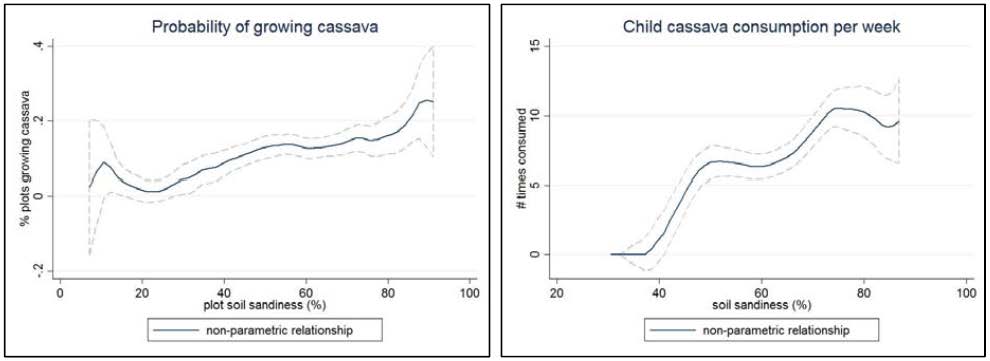As discussed in our previous post, soil quality influences the marginal productivity of land, fertilizer and other agricultural inputs, therefore impacting the quantity of food that can be produced on any given farm plot. Less well appreciated is the influence of soil health on food quality, and therefore on farmers’ consumption, health, and productivity, particularly in subsistence or semi-subsistence settings where production of food is strongly correlated with food consumption.
Soil quality influences food quality through several pathways – we’ll explore three of them here.
First, soil quality, as one factor defining agro-ecological zones, influences the types of crops that can be productively and profitably grown (Holmes & Lee 2012, Heumann et al. 2012). If food production is strongly predictive of food consumption—as shown by Hirvonen and Hoddinott (2014) in rural Ethiopia—then soil quality can influence both the types of food consumed and the dietary diversity achieved by smallholder farming families. Poor soil quality may also point towards the production of low-nutrition foods. In rural Uganda, for example, cassava is known to grow well on low-fertility, sandy soils; therefore farmers are more likely to grow cassava on sandy plots, and children from farms with sandy soils are more likely to eat more cassava (see figures below). Unfortunately, cassava is also the least nutritious staple grown in Uganda, providing starch and calories but almost no protein, vitamins, or minerals.

Second, soil nutrients, soil pH, and other soil characteristics influence the mineral content of food. Iodine exemplifies this relationship. Iodine is rare in the earth’s crust and found primarily in seawater. Thus, mountainous or inland areas, where wind and rain are unable to carry iodine in trace amounts from the sea, are most likely to have iodine-deficient soils (McDowell 2003). These are precisely the areas where iodine deficiency—the most common cause of preventable mental defects in the world today—and goiter are most widespread.
Iodine deficiency is not the only example of soil nutrients (or lack thereof) impacting the nutritional content of crops, human dietary intake, and human nutritional status. Keshan disease, caused by severe selenium deficiency, is found exclusively in (soil-) selenium-deficient areas of rural China. Soil pH and soil zinc concentration are associated with the zinc content of rice grown by smallholders and the zinc status of children in rural Bangladesh (Mayer et al. 2007).
Third, there is a tentative linkage between soil characteristics/soil management and aflatoxin contamination in cereals. Pre- and post-harvest contamination of aflatoxin in maize is a major health burden (including but not limited to childhood stunting, as described in Smith et al. (2012)) in tropical and sub-tropical regions of Sub-Saharan Africa. In 2004, for example, 125 people died and nearly 200 others were treated for illness after eating aflatoxin-contaminated maize in eastern and central Kenya.
Soil can serve as the primary habitat for Aspergillus flavus, the producer of maize aflatoxins, and higher soil populations of A. flavus have been found in soils with higher levels of soil organic matter (Zablotowicz et al. 2007). At the same time, since drought and heat stress are the principal contributing factors to aflatoxin contamination (Abbas et al. 2009), healthier soils that can better deal with moisture stress are also more likely to produce healthier plants that are less susceptible to aflatoxin contamination. Providing proper plant nutrition (especially adequate amounts of nitrogen) and controlling for insect pests are some other management practices that have effectively reduced the incidence of aflatoxin contamination in the field (Bruns 2003). Understanding the link between soil organic matter, other measures of soil health, and soil populations of A. flavus is, therefore, important to human health, and perhaps especially child health, in rural, agrarian Africa.
Looking forward
While these three links between soil quality and human health are fairly intuitive, empirical work on such topics is uncommon. It is well acknowledged that the suitability of crops varies across agro-ecological zones and soil types. Analysis of this linkage, however, often deals with crop productivity (e.g., Sivakumar and Valentin 2015) rather than crop choice. And while crop and soil scientists have long established that crop minerals vary with soils (as summarized in a recent literature review by Bevis (2015)), heterogeneity in crop micronutrient densities is typically assumed away by nutritionists and health economists. Empirical work tracing mineral transmission all the way from soils to humans (e.g., Mayer et al. 2007) is particularly rare.
More research is needed if we are to understand the implications of these linkages for human health and human productivity. For instance, it is commonly assumed that soil-to-human mineral transmission occurs on a regional basis only—but soil micronutrients, like macronutrients, vary widely by household and even by plot, and the health impacts of this variation are not well understood. It is also unclear how economic factors such as market integration, socio-economic status, or access to information impact this transmission. Investigating such linkages will require partnership between soil scientists, economists, and nutritionists. If soil health and human health are truly intertwined, accounting for these relationships may point towards win-win policy solutions that maximize multiple dimensions of smallholder welfare simultaneously.

